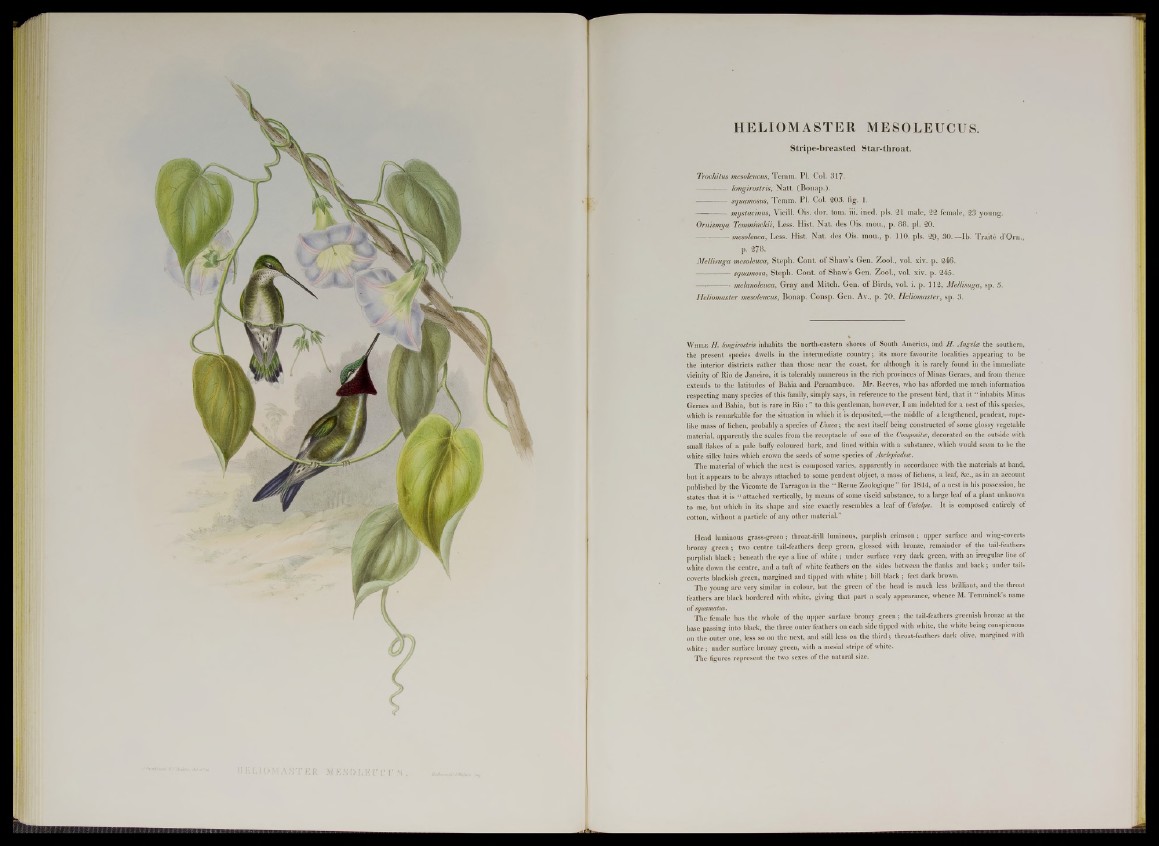
HELIOMASTER MESOLEUCUS.
Stripe-breasted Star-throat.
Trochilus mesoleucus, Teram. PI. Col. 317-
------ longirostris, Natt. (Bonap.).
---------------squamosus, Temm. PI. Col. 203. fig. 1.
mystacinus, Vieill. Ois. dor. tom. iii. ined. pis. 21 male, 22 female, 23 young.
Ornismya Temminckii, Less. Hist. N at. des Ois. mou., p. 88. pl. 20.
mesoleuca, Less. Hist. Nat. des Ois. mou., p. 110. pis. 29, 3 0 .—lb . Tra ité d’Orn.,
p. 278.
Mellisuga mesoleuca, Steph. Cont. o f Shaw’s Gen. Zool., vol. xiv. p. 246.
----------------squamosa, Steph. Cont. o f Shaw’s Gen. Zool., vol. xiv. p. 245.
melanoleuca, G ray and Mitch. Gen. of Birds, vol. i. p. 112, Mellisuga, sp. 5.
Heliomaster mesoleucus, Bonap. Consp. Gen. Av., p. 70, Heliomaster, sp. 3.
While H. longirostris inhabits the north-eastern shores of South America, and H. Angela: the southern,
the present species dwells in the intermediate country; its more favourite localities appearing to be
the interior districts rather than those near the coast, for although it is rarely found in the immediate
vicinity of Rio de Janeiro, it is tolerably numerous in the rich provinces of Minas Geraes, and from thence
extends to the latitudes of Bahia and Pernambuco. Mr. Reeves, who has afforded me much information
respecting many species of this family, simply says, in reference to the present bird, that it “ inhabits Minas
Geraes and Bahia, but is rare in Rio : ” to this gentleman, however, I am indebted for a nest of this species,
which is remarkable for the situation in which it is deposited,—the middle of a lengthened, pendent, ropelike
mass of lichen, probably a species of Usnea; the nest itself being constructed of some glossy vegetable
material, apparently the scales from the receptacle of one of the Composites, decorated on the outside with
small flakes of a pale buffy coloured bark, and lined within with a substance, which would seem to be the
white silkv hairs which crown the seeds of some species of Asclepiadeee.
The material of which the nest is composed varies, apparently in accordance with the materials at hand,
but it appears to be always attached to some pendent object, a mass of lichens, a leaf, &c., as in an account
published by the Vicomte de Tarragon in the “ Revue Zoologique” for 1844, of a nest in his possession, he
states that it is “ attached vertically, by means of some viscid substance, to a large leaf of a plant unknown
to me, but which in its shape and size exactly resembles a leaf of Catalpa. It is composed entirely of
cotton, without a particle of any other material.”
Head luminous grass-green; throat-frill luminous, purplish crimson ; upper surface and wing-coverts
bronzy green ; two centre tail-feathers deep green, glossed with bronze, remainder of the tail-feathers
purplish black; beneath the eye a line of white ; under surface very dark green, with an irregular line of
white down the centre, and a tuft of white feathers on the sides between the flanks and back; under tail-
coverts blackish green, margined and tipped with white; bill black ; feet dark brown.
The young are very similar in colour, but the green of the head is much less brilliant, and the throat
feathers are black bordered with white, giving that part a scaly appearance, whence M. Temminek’s name
of squamatus.
The female has the whole of the upper surface bronzy green ; the tail-feathers greenish bronze at the
base passing into black, the three outer feathers on each side tipped with white, the white being conspicuous
on the outer one, less so on the next, and still less on the third; throat-feathers dark olive, margined with
white; under surface bronzy green, with a mesial stripe of white.
The figures represent the two sexes of the natural size.